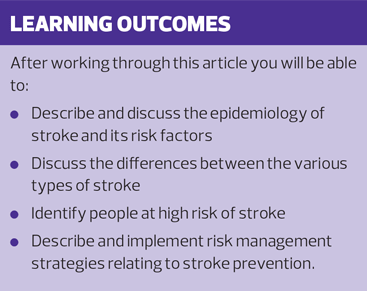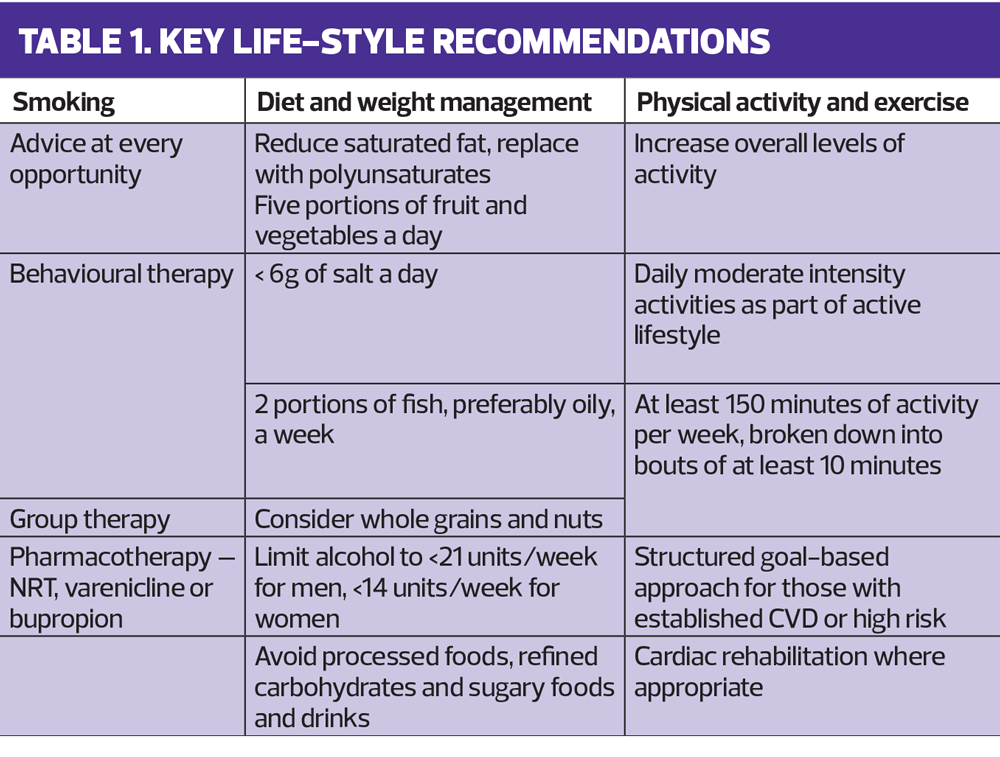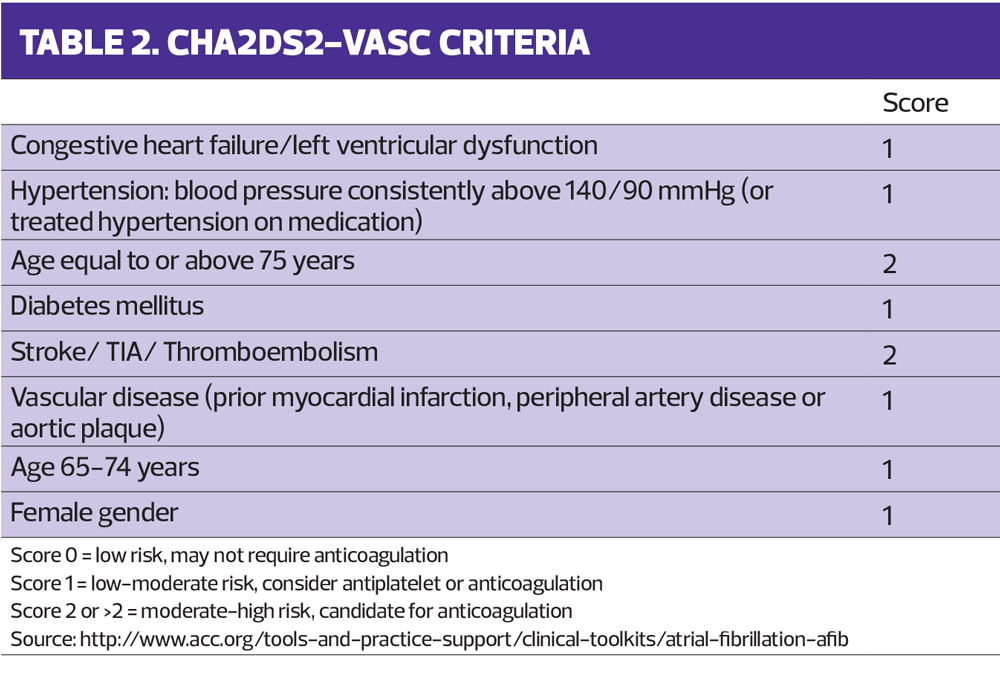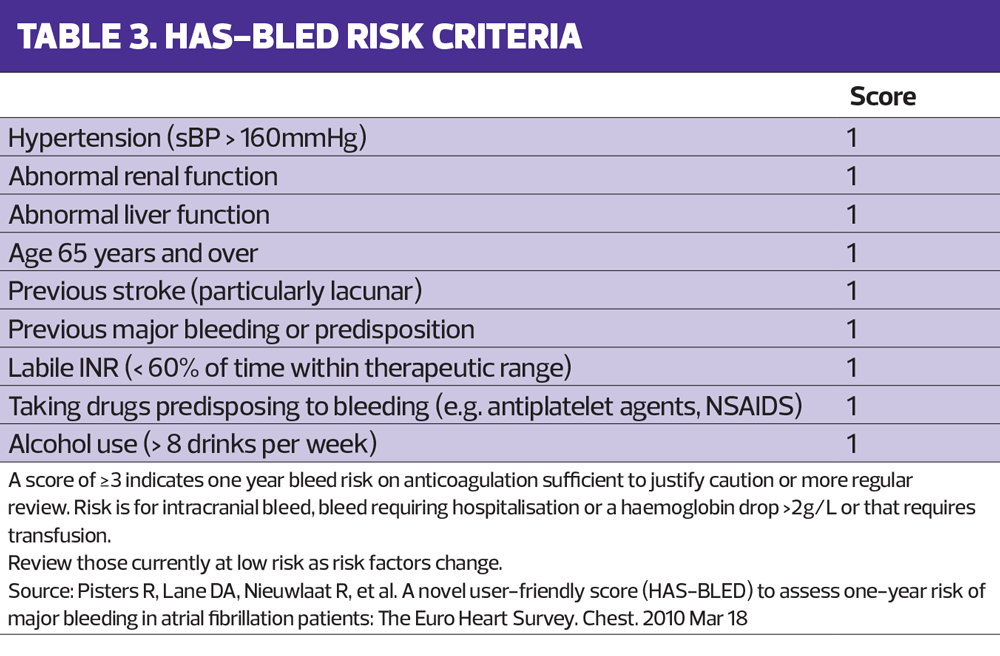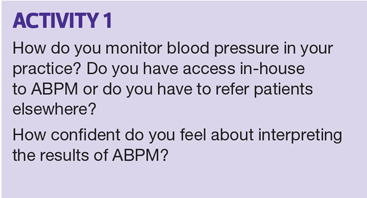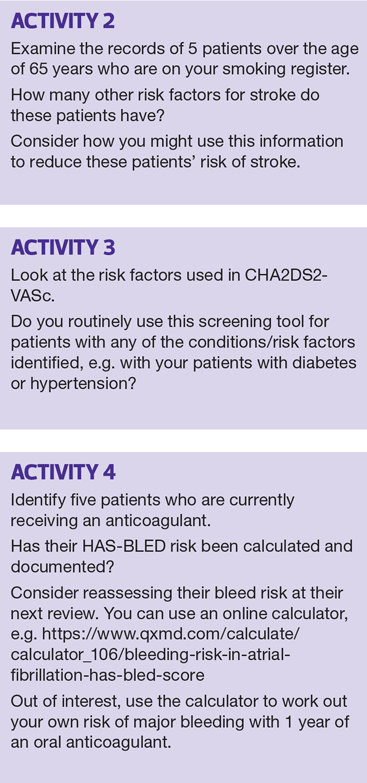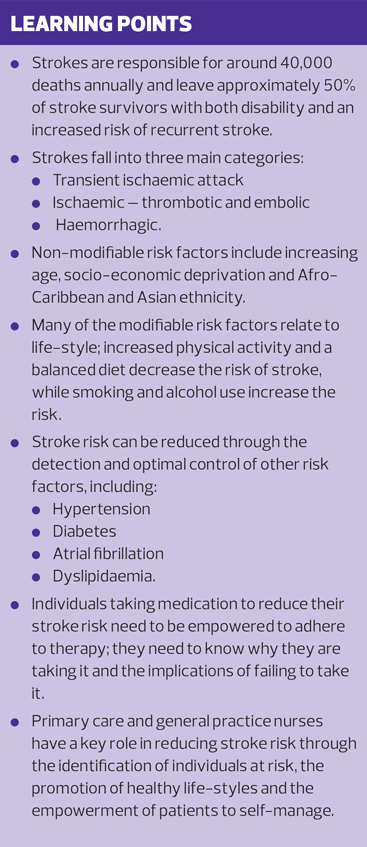Assessing and tackling risk factors for stroke
TARA GALLOWAY
TARA GALLOWAY
Stroke Association Interim Lead, South East Coast
AISLING LAKIN
Final Year Nursing Student (Adult nursing, BSc, Canterbury Christ Church University) and Stroke Association Ambassador
The long-term relationships that develop between primary care teams and patients make general practice the ideal place to intervene and support those at risk and reduce the human and financial costs of stroke
The World Health Organization defines stroke as ‘a clinical syndrome characterised by prolonged altered cerebral function, caused by vascular dysfuntion.’1 The most common symptoms include slurred speech, blurred vision, confusion, severe headache and weakness, which together can make stroke rehabilitation complex, lengthy and exhausting.1
Strokes are responsible for around 40,000 deaths annually and leave approximately 50% of stroke survivors with both disability and an increased risk of recurrent stroke.2 Having a stroke can negatively affect survivors’ quality of life, as well as that of their family and informal carers. However, with control of risk factors it is a preventable and treatable disease.
Not only can stroke have devastating effects on patients and their families, it also costs the UK economy around £7 billion per year.3 There are effective preventive measures and there is increasing evidence that timely intervention for those identified as being at high risk could greatly reduce both the financial and human costs.
TYPES OF STROKE
Transient Ischaemic Attack (TIA)
A TIA occurs when an insufficient systemic circulatory supply causes a temporary cerebral deficit. The signs and symptoms depend on the area of the brain affected by ischaemia. While this most commonly occurs within the anterior cerebral circulation such as the carotid territory, it can affect the posterior circulation, which would include the vertebrobasiliar territory, and this can contribute to a varied clinical presentation, similar to that of a stroke, including:
- Blurred vision
- Unilateral weakness
- Hemiplegia.
The defining difference between a TIA and stroke is the duration of the presenting signs and symptoms. A TIA is often referred to as a ‘warning sign’ because, unlike stroke, the signs and symptoms resolve within 24 hours without clinical input, therefore making it temporary in its presentation.4
This ‘temporary’ status, however, does not mean that it can be safely ignored. Approximately 46,000 people each year have a TIA and this can increase their future risk of stroke by nearly 20%.5 It has been found that, in the acute phase following a TIA, a person is more likely to suffer stroke than a stroke survivor is to have a recurrent stroke, making them a relatively ‘at risk’ patient group.5
It is therefore vital that, following a TIA, patients are assessed to identify whether they have any co-morbidities or features specifically increasing their risk of stroke. One scoring system that stratifies such risk is the ABCD2 scoring system, a calculation based on age, blood pressure, clinical features and duration of onset.6 (Box 1) This has been found to be most effective at specifically identifying those at medium to high risk so that timely intervention can be implemented to moderate risk factors and improve outcomes.
Following scoring, a patient is assessed to ensure they receive necessary clinical intervention. The Royal College of Physicians7 advises that following a TIA, there should be a discussion of individual lifestyle factors, paying particular attention to health promotion, with advice on smoking cessation, healthy diet, exercise and reducing alcohol intake. (Table 1) Clopidogrel, an antiplatelet drug designed to reduce platelet/thrombocyte production and the risk of future clot formation, should be prescribed. A 300mg loading dose should be given, followed by a regular 75mg once daily dose.7
If a patient was considered to be at increased risk of stroke due to high cholesterol levels, a high intensity statin such as atorvastatin, usually 20-80mg, should be prescribed.8 Finally, if the individual is found to be persistently hypertensive, antihypertensive agents (either a calcium channel blocker or angiotensin-converting-enzyme (ACE) inhibitors) should be prescribed.7,8
Ischaemic stroke
This is the most significant, accounting for 85% of strokes.3 It occurs when the presence of a clot in a blood vessel restricts blood flow and therefore oxygen and nutrients to the brain.
Unlike other tissues, the brain is unable to use gluconeogenesis as an energy source and cannot function in the absence of oxygen. When this supply is interrupted/cut off, there are no additional energy supplies that can be utilised to facilitate cerebral function. As a result, there is immediate cell death within the brain, which persists until oxygen supply can be restored. Again, unlike other tissues in the body, brain cells do not replicate which explains why ‘time taken’ relates to ‘brain lost’ in acute stroke care, highlighting the importance of rapid intervention to improve outcomes.
The ischaemic stroke category can be further divided into thrombotic and embolic, with thrombotic ischaemia generally occurring when a cerebral artery is blocked by a large thrombus. Due to the location of thrombotic ischaemia, a larger surface area of the brain will usually be deprived of oxygen. In embolic ischaemia, where an embolus has broken away from a larger clot, travelled through the blood stream to then occlude a smaller vessel, the area of brain deprived of oxygen is generally smaller.
Haemorrhagic stroke
While ischaemic injury is the most common type of stroke, haemorrhagic (bleeding) events account for 15% of stokes in the UK. Hypertension is a key predictor of its onset.
There are two main types of haemorrhagic stroke, related to the location of the bleed:
- Intracerebral bleeds – occurring within the brain
- Subarachnoid bleeds – occurring on the brain’s surface, causing intracranial pressure
Haemorrhagic strokes are associated with a higher risk of mortality, with 25% dying within 24 hours of the onset of the stroke.2
NON-MODIFIABLE RISK FACTORS
Some personal characteristics can make people more prone to stroke. Age is the most important risk factor, with a doubling of risk every decade after the age of 45.9 Men are more likely to have strokes than women and they are also more likely to have a stroke at a younger age.2
It has been found that economic status can also have an effect on stroke risk, with those living in deprived areas being twice as likely to have a stroke in comparison to those living in more affluent areas. Finally, ethnic origin can also play a part; people from Afro-Caribbean and Asian ethnic backgrounds have a higher incidence of hypertension and diabetes and this has a knock on effect, doubling their risk of stroke.
MODIFIABLE RISK FACTORS
Many of the risk factors for stroke relate to lifestyle, and are modifiable: increased physical activity and a balanced diet decrease the risk of stroke, while smoking and alcohol use increase the risk.10 Five major risk factors increase the likelihood of stoke, including hypertension, smoking status, visceral obesity, diet and physical activity. However, other factors such as atrial fibrillation and increased lipid levels also increase risk. If identified promptly, these risk factors can be modified and therefore risk reduced through health promotion aimed at increasing patient knowledge and empowering them to make lifestyle adjustments that will improve their health.11
Atherosclerosis
Atherosclerotic plaques form in the arterial wall as a result of complex processes involving interaction between smooth muscle cells in the arterial wall and blood components, including mediators of inflammation and immunity such as cytokines and complement factors. Plaques are most likely to occur where blood vessels branch or are irregular, causing abrupt changes in blood flow direction or velocity. Acute complications of atherosclerosis arise when a plaque ruptures, leading to thrombosis and complete or partial occlusion of the artery.
Atherosclerosis is both silent and cumulative, which explains why the risk of stroke increases with age: although atherosclerosis is generally considered a condition of older age, it can be present in young adults. Management involves not only revascularisation when an occluded vessel is detected, but systemic therapies to stabilise plaques and reduce thrombosis in order to reduce the risk of frank cardiovascular or cerebrovascular injury.
Risk factors for the development of atherosclerosis include:12
- Dyslipidaemia (high total cholesterol, elevated cholesterol: HDL ratio, raised LDL cholesterol, low HDL cholesterol, high triglyceride level)
- Hypertension
- Smoking
- Diabetes/insulin resistance
- Obesity
- Diet (high in saturated and trans fats, sodium and sugar)
- Systemic inflammation (elevated C-reactive protein [CRP])
- Sleep apnoea
- Alcohol.
Reducing these risk factors through health promotion is a fundamental part of the general practice nurse’s role.(Table 1)
Dyslipidaemia
Lipids are vital for digestion and hormone synthesis, but, as with everything, moderation is key! Abnormal levels contribute to the development of cardiovascular disease, including stroke.
A healthy lipid profile is:
- Total cholesterol < 4 mmol/L
- LDL cholesterol < 2 mmol/L.
The management of dyslipidaemia merits an article on its own. Suffice to say that if dietary modification does not reduce levels, the use of medications, such as statins, fibrates or selective cholesterol absorption inhibitors, is merited.
Diabetes
It is estimated that there are 4.5 million people living with diabetes in the UK (3.5 million of whom have a diagnosis). Ninety per cent of people with diabetes have type 2 diabetes, and this number is rising inexorably as the prevalence of type 2 diabetes continues to rise – 11.9 million people in the UK are at risk of developing type 2 diabetes.13 This is significant in terms of stroke care because diabetes can double an individual’s risk of ischaemic stroke.14
Possible mechanisms include,15:
- Vascular endothelial dysfunction
- Decreased nitric oxide-mediated vasodilation
- Injury to blood vessel walls caused by persistent hyperglycaemia resulting in increases in markers of inflammation
- Increased incidence of dyslipidaemia (causing increased viscosity)
- Increased incidence of hypertension.
Hypertension
Hypertension is one of the most important preventable causes of premature mortality in the UK, with 9.2 million diagnosed, and many more estimated to be living with hypertension but remaining undiagnosed.16 While there is a heredity component to the causes of hypertension, it is a modifiable risk factor which can be improved with medications and lifestyle changes.
Hypertension causes about 54% of all strokes,17 therefore, if hypertension in the UK was appropriately treated and controlled stroke prevalence could be significantly reduced. Like atherosclerosis, hypertension is a silent condition, and those who are affected are unaware of it. Practice nursing teams play a vital role in ensuring that patients are offered routine blood pressure checks, particularly if they are at high risk of hypertension.
Risk factors for hypertension include:18
- Family history
- Age
- Gender (until age 45, more common in men; age 45 – 64 years, equal rates; 65-plus, more common in women)
- Lack of physical activity
- Diet (excessive sodium)
- Overweight/Obesity
- Alcohol
- Smoking
- Stress
- Pregnancy
- Heart and/or kidney disease
- Sleep apnoea.
Currently the gold standard for the diagnosis of hypertension is ambulatory blood pressure monitoring (ABPM). NICE recommends that a diagnosis of hypertension is based on ABPM,16 since this has been found to be more effective at predicting future disease than standard, clinic monitoring. However, implementation is not universal: a survey of practices in south west England revealed that 27% had to refer patients for ABPM, 8% had no access, and only 69% of practices reported confidence in interpreting results.19
Home BP monitoring is an alternative to ABPM. Personal blood pressure kits are widely available, but home kits may be outdated, unreliable or uncalibrated. It is important to work with the patient to identify which testing method is appropriate for them, ensuring that patients are empowered to self-manage as much as possible and care is person centred, in line with the NMC Code.
Atrial Fibrillation (AF)
AF is a condition that causes electrical irregularity and disruption of the normal synchrony of the heart beat. This causes an irregular heart beat and affects blood flow through the heart. ‘Pooling’ of blood within the heart chambers increases the likelihood of clot formation, which can then break off causing embolic, ischaemic stroke. AF is now widely acknowledged as a major cause of stroke, and the leading risk factor in older patients.
Roughly 800,000 people in the UK have AF and therefore have an increased risk of stroke. To minimise this risk it is important to ensure that those with AF are on appropriate anticoagulation. It is questionable as to whether or not this is occurring in practice, with two-thirds of people admitted to hospital with a stroke not taking anticoagulants. AF is commonly asymptomatic and this could be a cause of its under-diagnosis. It is therefore important to opportunistically palpate the pulse manually, checking for any irregularity, particularly in older patients. If any irregularity is detected this must be followed up with an ECG.20
NICE advises that people diagnosed as having AF should be screened using the CHA2DS2-VASC tool.20 (Table 2). Patients scoring 2 or more should be offered anticoagulants, such as apixaban, rivaroxaban or warfarin, following assessment of their bleeding risk using the HAS-BLED score (Table 3). NICE also highlights the importance of annual follow up care to ensure that patients understand care plans and are adherent to prescribed pharmacotherapy.
It is important to note that the latest NICE AF guidance advises against the prescription of aspirin as an anti-platelet. Evidence shows that while aspirin carries similar bleeding risks to other available drugs, alternatives such as warfarin offer better stroke protection and should therefore be seen as ‘gold standard’.20,21 However, warfarin requires regular INR monitoring with adjustment of dosage. It also interacts with many commonly used drugs and foods. The use of novel oral anticoagulants such as apixaban and rivaroxaban may be preferable.22
ADHERENCE TO MEDICATION
Up to 50% of prescribed medication is not taken as intended by the prescriber and between 5% and 8% of all unplanned hospital admissions are due to medication issues. This figure rises to 17% in the over-65s. The estimated lost opportunity cost of health gains foregone because of incorrect or inadequate medicines in just five clinical contexts is in excess of £500m a year.23 Patient involvement in decisions about drug use is fundamental in prescribing, particularly in the context of polypharmacy, conservatively defined as the concurrent prescription of five or more drugs.24 This is relevant to stroke prevention, where patients may be receiving treatment for hypertension, dyslipidaemia, diabetes, together with an anticoagulant – and quite possibly, nicotine replacement therapy.
Increasing knowledge among patients at risk of stroke may not only improve concordance and adherence, but also reduce the risk of adverse events arising from the misuse of medication. To implement this at ground level, practice nurses should check patients’ understanding of their medication, ensuring they know what they are taking, why they are taking it and the repercussions of stopping.
This is particularly applicable to stroke care where many of the risk factors, such as hypertension or high cholesterol are asymptomatic and may be poorly understood by the patient. Similarly, many of the medications used to modify risk may have side effects – such as cough with ACE inhibitors, or postural hypotension with diuretics, beta blockers and calcium channel blockers – and these can effect adherence. Highlighting the frequency and duration of side effects (many of which become less bothersome with time) can assist in the development of care plans appropriate to the individual’s needs. This long term approach is particularly important in stroke care because the underlying conditions can only be controlled, not cured, and the patient needs to be central to their own care.
CONCLUSION
Strokes are common and are a major issue, for patients and health service alike. Yet in many cases strokes are preventable if the risk factors can be identified and those at risk offered appropriate interventions – life-style modification and/or medication.
The long-term relationships that develop between primary care teams, patients, and their families, make general practice the ideal place to intervene and support those at risk and reduce the human and financial costs of stroke.
- Next month: Life after stroke – what needs to be done to improve survivors’ care
REFERENCES
1. World Health Organization. Stroke, Cerebrovascular accident, 2017. http://www.who.int/topics/cerebrovascular_accident/en/
2. The Stroke Association. State of the Nation. London. 2016. https://www.stroke.org.uk/sites/default/files/stroke_statisics_ 2015.pdf
3. Feigin V, Forouzanfar M, Krishnamurthi R, et al. Global and regional burden of stroke during 1990–2010: findings from the Global Burden of Disease Study, The Lancet 2014;383(9913):245-255
4. Patient.co.uk. Transient Ischaemic Attacks. 2017. https://patient.info/doctor/transient-ischaemic-attacks
5. Coull AJ, Lovett JK, Rothwell PM. Population based study of early risk of stroke after transient ischaemic attack or minor stroke: implications for public education and organisation of services. BMJ 2004;328(7435):326
6. Bhatt A, Jani V. The ABCD and ABCD2 scores and the risk of stroke following a TIA: a narrative review. International Scholarly Research Network Neurology 2011;.Article ID 518621, http://dx.doi.org/10.5402/2011/5186212011;2011:1–12.
7. Royal College of Physicians. Intercollegiate Stroke Working Party. National clinical guideline for stroke, 5th edition. London: Royal College of Physicians 2016. https://www.rcplondon.ac.uk/guidelines-policy/stroke-guidelines
8. National Stroke Association. Transient Ischaemic Attack: Prognosis and Key Management Considerations, 2017. https://www.stroke.org/sites/default/files/resources/tia-abcd2-tool.pdf
9. Kelly-Hayes M. Influence of age and health behaviours on stroke risk: lessons from longitudinal studies. Journal of the American Geriatrics Society. 2010;58:S325-S328.
10. O’Donnell M, Xavier D, Liu L, et al. Risk factors for ischaemic and intracerebral haemorrhagic stroke in 22 countries (the INTERSTROKE study): a case-control study. The Lancet 2010; 376(9735): 112-123.
11. Hooker S, Sui X, Colabianchi N, et al. Cardiorespiratory fitness as a predictor of fatal and nonfatal stroke in asymptomatic women and men. Stroke 2008; 39(11):2950-2957
12. Patient.co.uk. Atherosclerosis. 2017 https://patient.info/doctor/atherosclerosis
13. Diabetes UK. Facts and stats, October 2016. https://www.diabetes.org.uk/Documents/Position%20statements/DiabetesUK_Facts_Stats_Oct16.pdf
14. Luitse M, Biessels G, Rutten G, et al. Diabetes, hyperglycaemia and acute ischaemic stroke. Lancet Neurol 2012;11(3):261-71
15. Chen R, Ovbiagele B, Feng W. Diabetes and stroke; epidemiology, pathophysiology, pharmaceuticals and outcomes. Am J Med Sci 2016;351(4):380-86. https://www.ncbi.nlm.nih.gov/pmc/articles/PMC5298897/
16. NICE CG127. Hypertension in adults: diagnosis and management, 2011 https://www.nice.org.uk/guidance/cg127/resources/hypertension-in-adults-diagnosis-and-management-pdf-35109454941637
17. Gaciong Z, Siniski M, Lewandowski J. Blood pressure control and primary prevention of stroke: summary of the recent trial data and meta-analyses. Current Hypertension Reports 2013;15(6):550-74 https://www.ncbi.nlm.nih.gov/pmc/articles/PMC3838588/
18. American Heart Association. Know your risk factors for high blood pressure, 2017. http://www.heart.org/HEARTORG/Conditions/HighBloodPressure/UnderstandSymptomsRisks/Know-Your-Risk-Factors-for-High-Blood-Pressure_UCM_002052_Article.jsp#.WP3_oVKZP64
19. Mejzner N, Clarke C, Smith L, Campbell J. What changes have occurred in the organisation of care for hypertension and how are current diagnostic guidelines implemented within primary care in SW England. Poster. Society for Academic Primary Care, Dublin 2016. https://sapc.ac.uk/conference/2016/abstract/what-changes-have-occurred-organisation-of-care-hypertension-and-how-are
20. NICE. Atrial fibrillation: management; Press release, 2014 https://www.nice.org.uk/guidance/cg180/resources/thousands-of-strokes-in-people-with-common-heart-rhythm-disorder-are-avoidable-says-nice
21. Mant J, Hobbs F, Fletcher K. Warfarin versus aspirin for stroke prevention in an elderly community population with atrial fibrillation (the Birmingham Atrial Fibrillation Treatment of the Aged Study, BAFTA): a randomised controlled trial. Lancet 2007;370:493–550
22. Connolly S, Ezekowitz M, Yusuf S. Dabigatran versus warfarin in patients with atrial fibrillation. New Engl J Med 2009; 361:1139–51
23. NHS England. Medicine optimisation background. https://www.england.nhs.uk/ourwork/pe/mo-dash/background/
24. The King’s Fund. Polypharmacy and medicines optimisation: Making it safe and sound, 2013. https://www.kingsfund.org.uk/sites/files/kf/field/field_publication_file/polypharmacy-and-medicines-optimisation-kingsfund-nov13.pdf
Related articles
View all Articles
